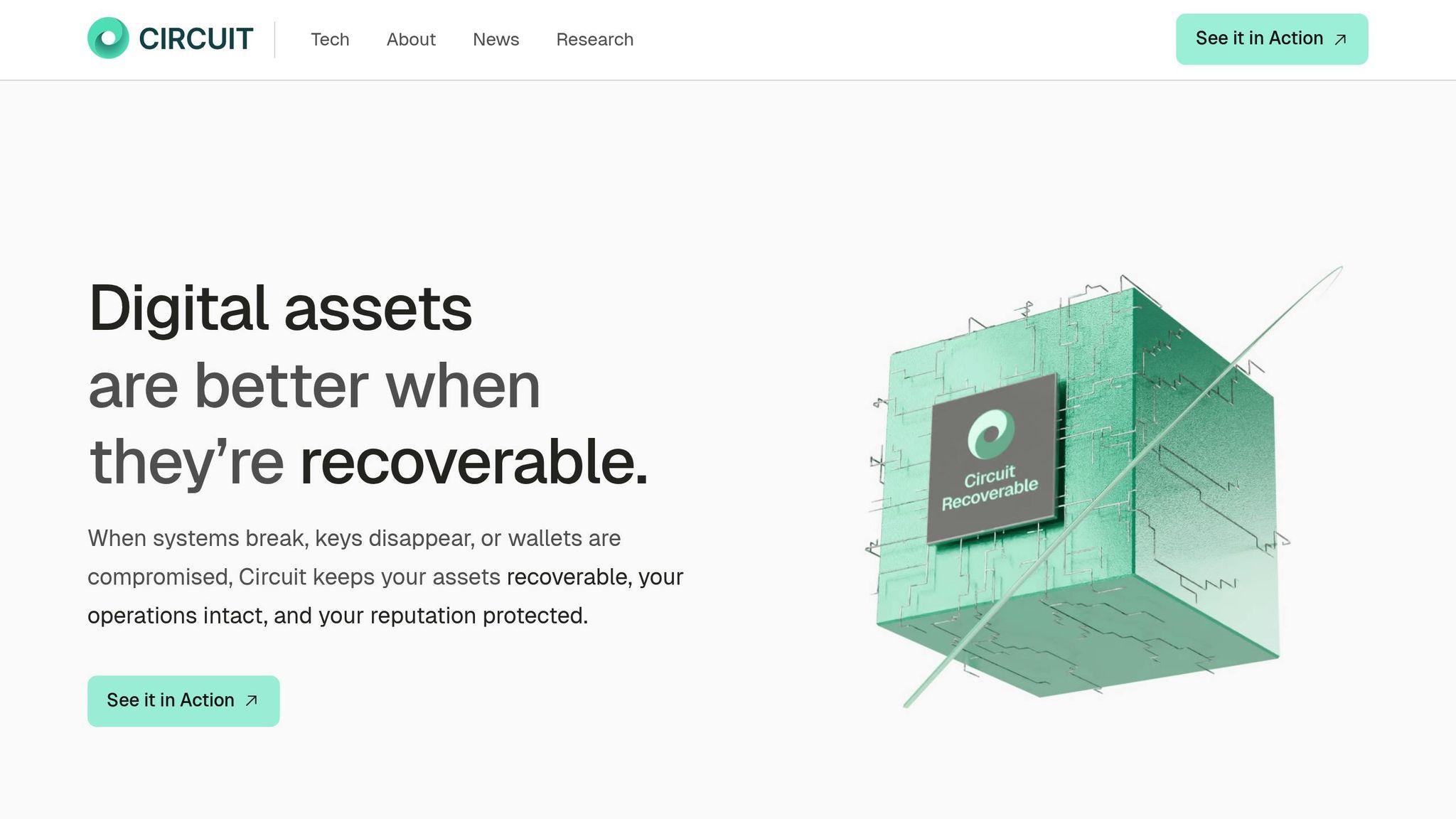Losing access to cryptocurrency keys can mean permanent loss of funds. For institutions managing digital assets, key recovery systems are essential to prevent financial disasters. Here’s a quick breakdown of what you need to know:
- Private Keys: These are unique, confidential 256-bit numbers that control access to cryptocurrency. Losing them is irreversible without backups.
- Challenges for Institutions: Regulatory compliance, managing multiple wallets, balancing access among staff, and ensuring business continuity are key hurdles.
- Key Recovery Systems: Institutions rely on encrypted backups, multi-signature wallets, and Multi-Party Computation (MPC) to secure and recover keys.
- Access Controls: Role-based permissions, biometrics, and time-based safeguards reduce risks of breaches or unauthorized actions.
- Testing and Documentation: Regular drills, clear protocols, and updated documentation ensure recovery procedures work when needed.
Institutions must combine advanced technology with strict protocols to safeguard digital assets, meet regulatory expectations, and stay operational in emergencies.
Harry Donnelly | Digital Asset Recovery Technology with Circuit (Episode 544)

Key Components of Secure Recovery Systems
Creating a secure and reliable key recovery system involves layering multiple protective measures to address potential failure scenarios. Institutions need to combine backup strategies, access controls, and incident response plans to ensure effective and secure recovery processes.
Backup Methods and Redundancy
At the heart of any institutional key recovery system are encrypted backups. These backups should rely on AES-256 encryption to keep underlying keys safe. To bolster security, encryption keys must be stored separately from the backup files themselves.
Geographic distribution is another critical factor. By spreading backups across at least three distinct regions, institutions can reduce the risk of losing data due to localized events. Some organizations even go a step further, storing copies on different continents to prepare for large-scale disruptions.
The timing and frequency of backups are equally important. Automated scheduling ensures regular backups, with additional backups triggered by key events. However, automation alone isn’t enough – verification processes must confirm that backups are successfully created and accessible.
For added security, air-gapped storage keeps certain backups offline, making them immune to cyberattacks. Many institutions use hardware security modules (HSMs) stored in bank vaults or other highly secure facilities for their most critical backups. These offline measures act as a last line of defense in case online systems are compromised.
While these backup strategies are crucial, they must be paired with secure access mechanisms and a readiness to respond to incidents quickly.
Multi-Signature Wallets and Multi-Party Computation (MPC)
Multi-signature wallets are a practical way to distribute control and eliminate single points of failure. For instance, an institutional wallet might require three out of five authorized signatures to approve transactions. This setup ensures that even if two keys are compromised or unavailable, the institution can still access its funds through the remaining signers.
Different configurations can be tailored to specific needs. For example, high-value cold storage wallets might require four out of six signatures, while more frequently used wallets for daily operations might adopt a two-out-of-three setup for faster transactions. The goal is to strike a balance between security and operational efficiency.
Multi-Party Computation (MPC) takes security a step further by splitting private keys into fragments. Transactions are signed using cryptographic protocols without ever reconstructing the full key. This approach eliminates the risk of a single point of failure.
MPC systems are particularly useful for institutions managing large digital asset portfolios or operating in high-risk environments. Even if some parties holding key fragments are compromised, attackers cannot access the funds unless they breach a sufficient number of participants.
The effectiveness of MPC relies on threshold schemes, which determine how many participants must authorize a transaction. For example, a system requiring three out of five participants offers both security and flexibility. This ensures operations can continue even if one or two participants are unavailable, while attackers would need to compromise at least three parties to gain unauthorized access.
While these technical measures protect the integrity of keys, secure access controls and a solid incident response plan are essential for effective recovery.
Access Controls and Incident Response
Technical safeguards alone aren’t enough – strong access controls and well-designed incident response protocols are critical for addressing human and operational risks.
Role-based access permissions limit who can initiate key recovery procedures, adhering to the principle of least privilege. This means individuals are granted only the access necessary for their specific roles. For high-value transactions, additional safeguards like supervisor approval can be implemented.
Biometric authentication adds another layer of protection. Multi-factor biometric systems, such as fingerprints, iris scans, or voice recognition, make unauthorized access significantly harder. Some organizations even use behavioral biometrics, which analyze patterns like typing or mouse movements, to detect suspicious activity.
Time-based access controls create further safeguards by restricting when key recovery procedures can be initiated. For example, institutions might enforce a 24-hour delay for large transactions or recovery requests. This "cooling-off" period provides time to detect and respond to unauthorized attempts while ensuring legitimate operations proceed smoothly after the delay.
An incident response plan is essential for handling emergencies. These plans should outline specific actions for scenarios like compromised keys, unavailable personnel, technical failures, or natural disasters affecting backup locations. Clear escalation procedures, communication protocols, and decision-making frameworks are vital components of these plans.
Regular drills are crucial to validate these procedures. Simulating realistic scenarios – such as the unavailability of primary personnel – helps identify weaknesses and improve readiness. Documenting drill results provides valuable insights for refining recovery strategies.
Finally, audit trails ensure accountability and help detect unauthorized access attempts. Logs should record details such as who accessed the system, when, what actions were taken, and the reasons behind them. To maintain integrity, these logs should be immutable, securing them for investigations and compliance purposes.
How to Implement Key Recovery Protocols
Implementing secure key recovery involves understanding your institution’s needs, choosing the right custody model, and rigorously testing procedures. These steps build on the security measures discussed earlier.
Assess Your Institution’s Needs
Start by evaluating your organization’s risk profile and operational requirements. The value of your digital assets plays a key role in determining the level of security needed. For instance, institutions managing high-value assets often require advanced, multi-layered security systems to ensure redundancy and protection. On the other hand, organizations handling high transaction volumes must strike a balance between robust security and operational efficiency.
Regulatory compliance is another critical factor. Whether you’re a traditional bank, a cryptocurrency exchange, or an investment fund, your recovery protocols must align with the specific audit trails, custody arrangements, and recovery timelines required by governing bodies. Additionally, your institution’s risk tolerance will shape your strategy. Conservative organizations may mandate unanimous approval for recovery actions, while others might implement a majority-vote system. Tailor your recovery procedures to match your institution’s complexity and the expertise of your team.
Choose a Custody Model
Selecting the right custody model is essential for secure backups and controlled access. Each approach comes with its own strengths and trade-offs, so the choice should align with your risk profile and operational needs. Here’s a breakdown of common custody models:
| Custody Model | Control Level | Security | Cost | Recovery Speed | Best For |
|---|---|---|---|---|---|
| Self-Custody (HSM) | Full | High | High upfront | Fast | Institutions with strong technical expertise |
| Self-Custody (MPC) | Full | Very High | Moderate to High | Moderate | Organizations prioritizing enhanced security |
| Hybrid Custody | Shared | High | Moderate | Moderate | Institutions seeking a mix of control and support |
| Third-Party Custody | Limited | Variable | Low to Moderate | Variable | Organizations preferring outsourced management |
Each custody model offers different balances between control, security, speed, and cost. Choose the one that best fits your institution’s risk tolerance and available resources.
Test and Document Recovery Procedures
Once you’ve chosen a custody model, it’s time to validate its effectiveness. Regular testing is critical – run recovery drills frequently and use varied team configurations to ensure your protocols meet required benchmarks for speed and reliability.
Clear documentation is equally important. Outline every step of the recovery process, define roles, and include troubleshooting guidelines. Keep these documents accessible during emergencies by storing secure copies in multiple locations, both digital and offline.
To avoid single points of failure, assign primary and backup personnel and provide cross-training for team members. As systems and regulations evolve, implement change management processes to keep documentation up to date. Set performance metrics, such as recovery speed and success rates, and review them periodically. External audits can also provide an extra layer of assurance that your recovery procedures meet industry standards.
sbb-itb-c5fef17
Best Practices and Common Mistakes in Key Recovery
Building a reliable key recovery system isn’t just about having the right tools – it’s about preparation, redundancy, and constant vigilance. By learning from what works (and what doesn’t), institutions can strengthen their approach to safeguarding cryptographic keys.
Best Practices for Institutions
Store high-value assets offline. For maximum security, keep the bulk of your cryptographic keys in offline environments like hardware security modules (HSMs) or air-gapped systems. This minimizes exposure to online threats while ensuring authorized personnel can still access keys when needed.
Schedule quarterly security audits. Regular audits should cover both technical systems and human protocols. This includes checking access logs, verifying the integrity of backups, and ensuring staff adhere to security policies.
Implement dual-factor authentication. Combine methods like passwords, hardware tokens, or biometrics for key recovery actions. This extra layer makes it much harder for unauthorized users to gain access, even if one method is compromised.
Distribute backups across multiple locations. Geographic dispersion is critical. By storing backups in different regions, you reduce the risk of localized disruptions – like natural disasters or power outages – hindering recovery efforts.
Use time-locked recovery mechanisms. For high-value transactions, enforce mandatory waiting periods before recovery actions are completed. This delay gives your security team time to verify requests and detect any suspicious activity, a practice widely used in managing large cryptocurrency portfolios.
Maintain compliance with U.S. regulations. Keep detailed, tamper-proof logs of all recovery activities. These records should include timestamps, authorized personnel, and specific actions taken, ensuring they’re ready for audits or regulatory reviews.
Common Mistakes to Avoid
Overlooking robust backup strategies. Relying on a single backup or storing all backups in one place is a recipe for disaster. If that location becomes inaccessible or compromised, recovery may be impossible.
Allowing single points of failure. No single person, device, or location should control access to critical keys. Key recovery systems must account for scenarios like employee departures or technical failures to ensure operations can continue seamlessly.
Weak access controls. Convenience should never come at the expense of security. Avoid shared accounts, generic passwords, or overly broad permissions. Each user should have unique credentials, with access strictly limited to their role.
Failing to train staff. Unprepared employees can delay recovery or even jeopardize security. Cross-train multiple team members to prevent knowledge silos and ensure smooth transitions during personnel changes.
Relying on outdated documentation. Procedures need to evolve alongside your systems. If recovery protocols reference outdated systems, incorrect contacts, or obsolete security measures, they can cause confusion or failures during emergencies.
Repeating the same drills. Running identical recovery scenarios over and over can create blind spots. Mix up team configurations, timing, and scenarios to uncover weaknesses in your protocols.
Neglecting incident response planning. Without a clear plan, institutions may scramble during emergencies. Define escalation procedures, communication methods, and decision-making frameworks in advance. Know who has the authority to approve recovery operations and how to reach them after hours.
The best key recovery systems blend strong technical safeguards with well-trained teams and dynamic procedures. Regularly reviewing and refining these systems ensures they remain effective as new challenges and technologies emerge. These foundational practices set the stage for the advanced recovery solutions discussed next.
Advanced Solutions and Legal Requirements
As institutions grow their involvement in cryptocurrency, adopting sophisticated approaches to key recovery becomes a necessity. This often means collaborating with experts and ensuring that legal and governance frameworks are strong enough to handle the risks tied to digital assets. These measures go beyond basic practices, laying a stronger foundation for secure operations.
Working with Qualified Custodians
Qualified custodians bring institutional-grade infrastructure and security to the table. They standardize security protocols and deploy specialized teams to address operational risks. Many custodians also offer insurance plans tailored for digital assets, providing protection against insider threats, cyberattacks, and other operational challenges. Additionally, their adherence to industry standards and frequent audits can help streamline the process of meeting regulatory requirements.
Legal and Governance Requirements
Beyond custody partnerships, having board-level oversight with expertise in blockchain or cybersecurity is critical. Institutions should conduct thorough vendor due diligence to assess the technical capabilities and disaster recovery practices of their custodians. Legal documentation plays a key role here – contracts and policies must clearly define key recovery authorization, emergency access protocols, and the allocation of liability between the institution and its custodian.
How Bestla VC Supports Institutional Key Management

Bestla VC plays a pivotal role in simplifying key management for institutions by leveraging advanced cryptography and decentralized infrastructure. With a focus on digital finance and over-the-counter (OTC) market solutions, the firm offers practical insights into designing secure and compliant key recovery systems. Bestla VC also provides legal consultancy services, helping organizations structure custody arrangements, develop governance frameworks, and maintain clear documentation for key management processes. Drawing on its expertise at the intersection of AI and Web3, Bestla VC delivers forward-thinking solutions that address modern security challenges while maintaining operational efficiency.
Conclusion: Building Reliable Key Recovery Systems
Creating a dependable key recovery system requires careful planning, consistent testing, and a firm commitment to security. Leading institutions understand that key recovery isn’t a one-time task – it’s a continuous process that must adapt to both technological progress and shifting regulations. This section pulls together technical strategies and governance practices to outline a framework for resilient recovery.
Effective recovery strategies hinge on aligning the right technology – whether it’s multi-signature wallets, MPC (multi-party computation), or custodial services – with your institution’s specific risk profile, governance structure, and compliance needs. Even the most advanced security tools lose their value if they’re not properly documented, regularly tested, and fully understood by your team.
Regular drills and updated documentation play a critical role in ensuring recovery plans work when they’re needed most. These practices help teams stay prepared and ensure that procedures function as intended during real-world emergencies.
With regulations constantly evolving, institutions need board-level involvement and specialized legal expertise to stay compliant. The unique challenges of balancing cryptocurrency’s decentralized framework with traditional financial regulations often require a combination of cybersecurity knowledge and legal insight. Clear documentation of authorization processes, liability distribution, and emergency protocols safeguards both the institution and its stakeholders.
As the cryptocurrency landscape grows more sophisticated, institutions now have access to advanced solutions that combine cutting-edge cryptography with practical operational tools. The challenge lies in choosing partners and technologies that not only meet today’s needs but are flexible enough to handle future demands. This often means working with custodians who offer institutional-grade security, insurance options, and support for regulatory compliance.
Ultimately, prioritizing digital asset security on the same level as traditional finance is key to successful key recovery. This involves investing in robust infrastructure, enforcing strict operational procedures, and staying proactive as threats and opportunities evolve. Institutions that adopt this comprehensive approach are better equipped to navigate the expanding digital asset economy while safeguarding their stakeholders’ interests. Bestla VC exemplifies these principles, offering advanced solutions to help institutions remain secure in an ever-changing environment.
FAQs
What makes Multi-Party Computation (MPC) a better choice for institutional key management compared to traditional methods?
Multi-Party Computation (MPC) takes security to the next level by splitting private keys into multiple fragments. This means no single person or system ever holds the entire key, eliminating a single point of failure. The result? Stronger protection against both cyberattacks and insider threats – far beyond what traditional methods can provide.
MPC also shines when it comes to flexibility and availability. It enables key signing to happen across different locations, ensuring seamless operations whether you’re working in the cloud or on-premises. Compared to hardware security modules (HSMs), MPC offers modern institutions managing digital assets a more adaptable and scalable solution.
How can institutions stay compliant with regulations when setting up crypto key recovery systems?
To stay within regulatory boundaries while deploying crypto key recovery systems, organizations must prioritize secure key management and thorough record-keeping. This means leveraging tools like hardware security modules (HSMs), enforcing stringent access controls, and defining clear policies for managing keys throughout their lifecycle.
On top of that, a well-structured compliance program is crucial. Such a program should outline potential risks, document key recovery processes, and ensure all practices align with current regulations. Regularly monitoring updates in regulatory requirements can help reduce both operational and legal risks.
How can institutions ensure secure key recovery during a cyberattack or natural disaster?
To safeguard key recovery processes, institutions need to have a well-thought-out disaster recovery plan in place. This means keeping encrypted backups in highly secure locations, like hardware security modules or offline vaults, and routinely running recovery drills to ensure everything works as intended.
Clear documentation of recovery procedures is a must, along with assigning specific roles to team members responsible for overseeing the process. Automated key management systems can streamline these efforts. Additionally, storing backups in multiple, geographically distant locations adds an extra layer of protection, allowing for faster recovery during emergencies. This approach helps protect critical assets and keeps operations running smoothly.


